Abstract
Mutations causing mitochondrial defects were induced in a virulent strain of the chestnut blight fungus Cryphonectria parasitica (Murr.) Barr. Virulence on apples and chestnut trees was reduced in four of six extensively characterized mutants. Relative to the virulent progenitor, the attenuated mutants had reduced growth rates, abnormal colony morphologies, and few asexual spores, and they resembled virus-infected strains. The respiratory defects and attenuated virulence phenotypes (hypovirulence) were transmitted from two mutants to a virulent strain by hyphal contact. The infectious transmission of hypovirulence occurred independently of the transfer of nuclei, did not involve a virus, and dynamically reflects fungal diseases caused by mitochondrial mutations. In these mutants, mitochondrial mutations are further implicated in generation of the attenuated state by (i) uniparental (maternal) inheritance of the trait, (ii) presence of high levels of cyanide-insensitive mitochondrial alternative oxidase activity, (iii) cytochrome deficiencies, and (iv) structural abnormalities in the mtDNA. Hence, cytoplasmically transmissible hypovirulence phenotypes found in virus-free strains of C. parasitica from recovering trees may be caused by mutant forms of mtDNA.
Full text
PDF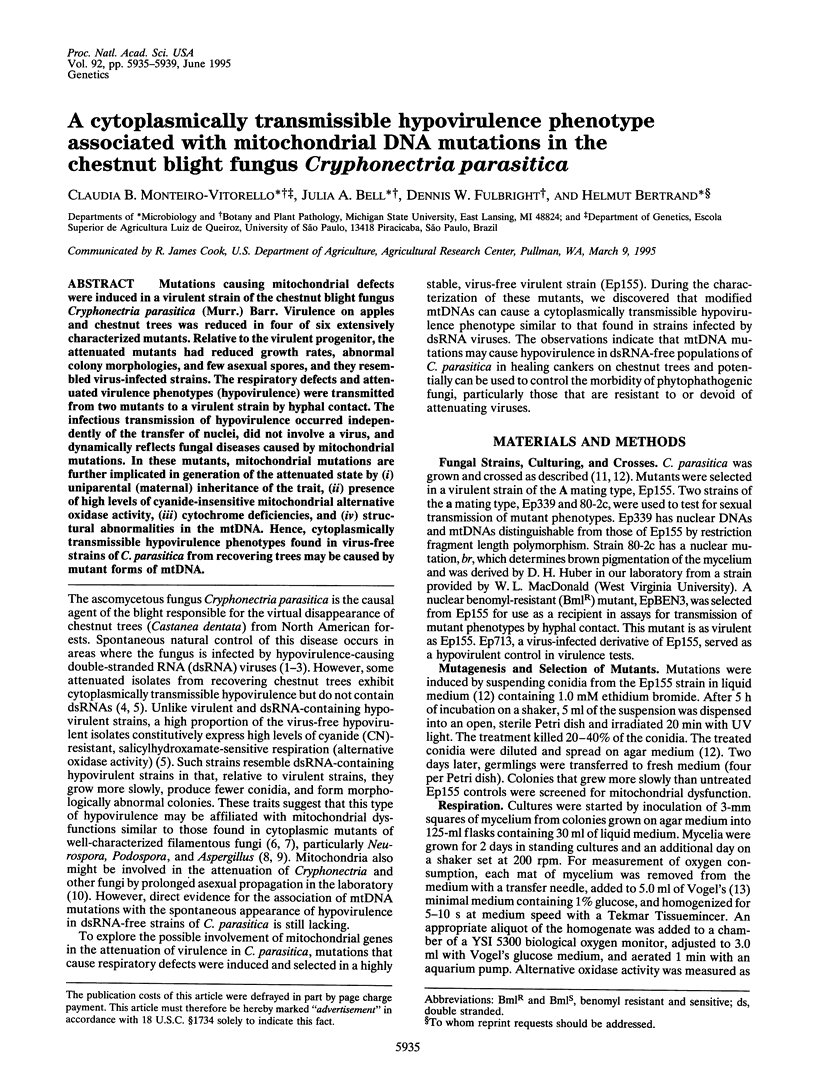
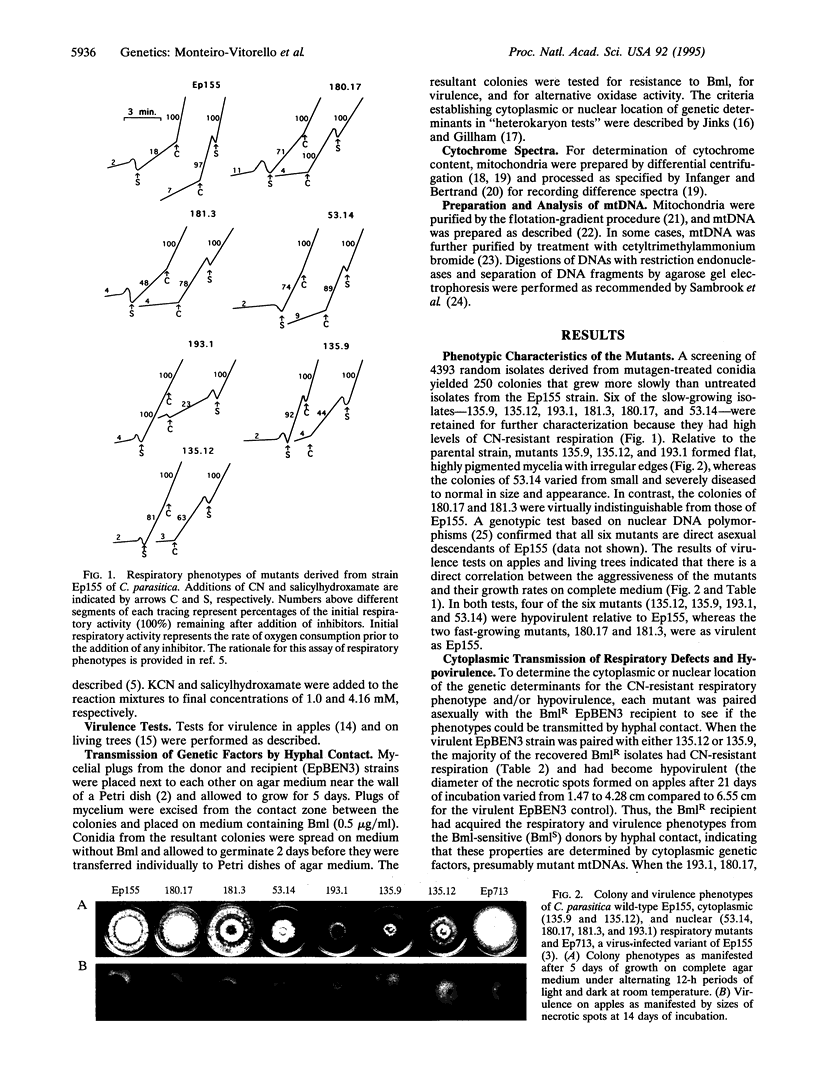
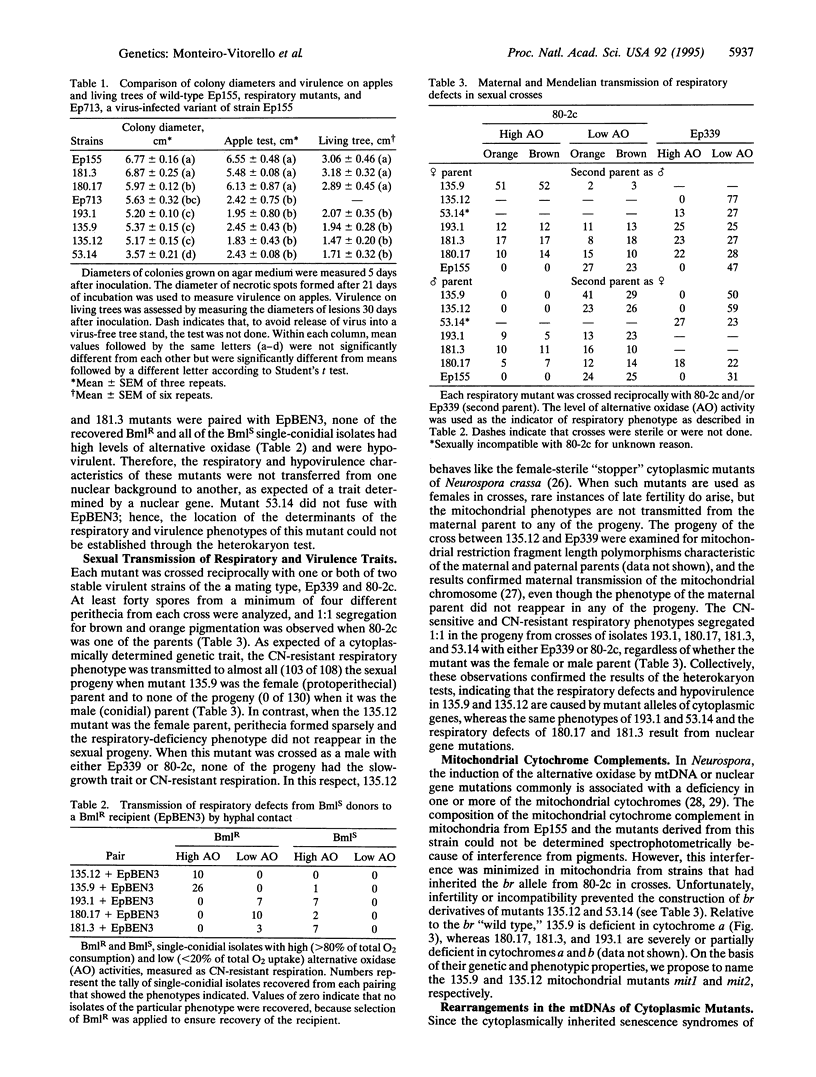
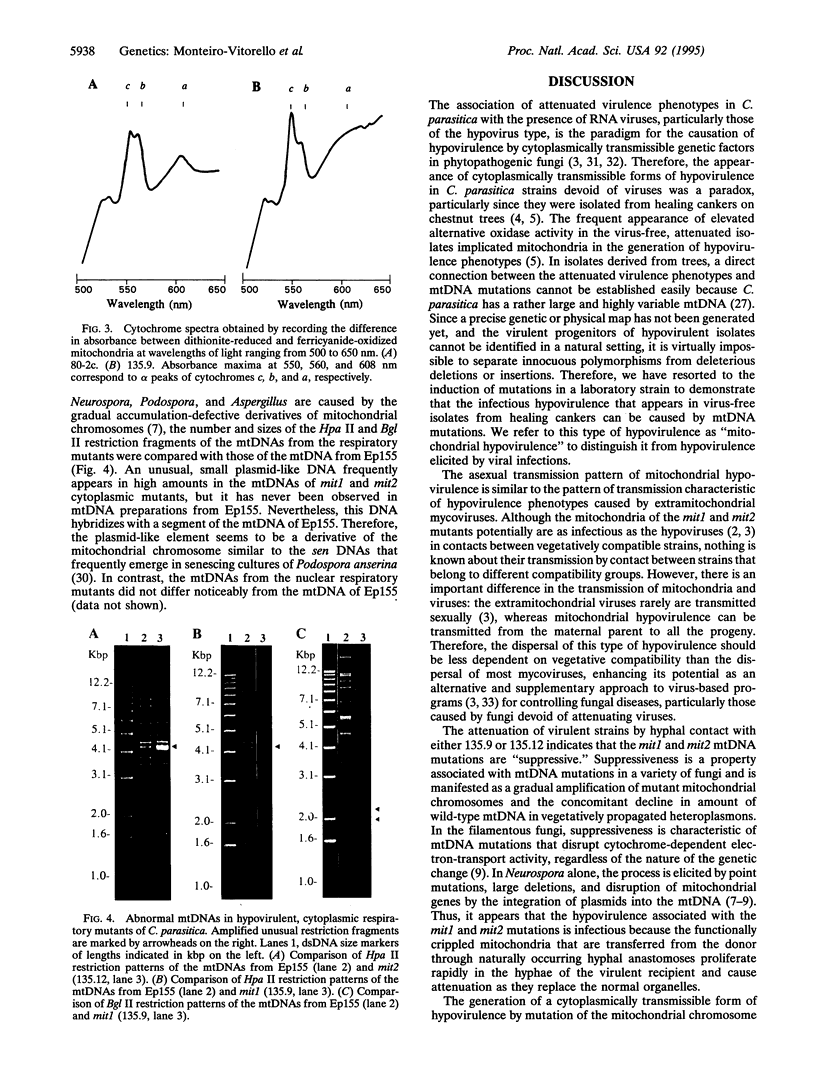
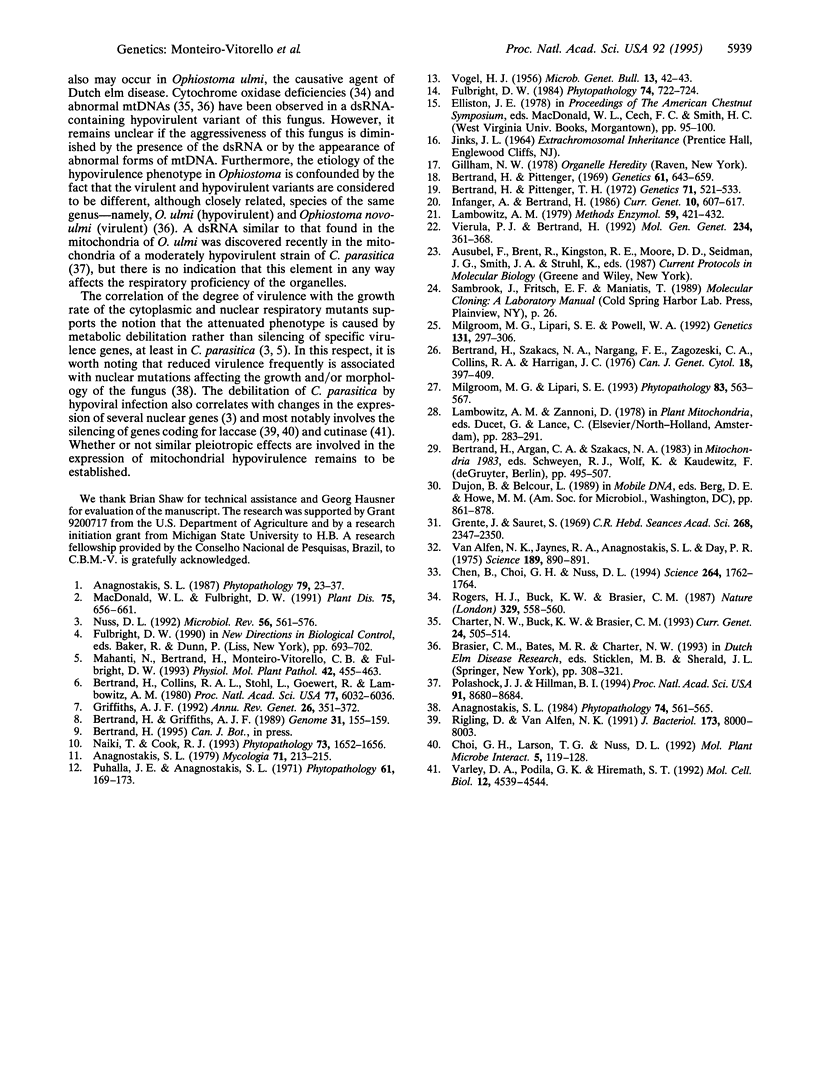
Images in this article
Selected References
These references are in PubMed. This may not be the complete list of references from this article.
- Bertrand H., Collins R. A., Stohl L. L., Goewert R. R., Lambowitz A. M. Deletion mutants of Neurospora crassa mitochondrial DNA and their relationship to the "stop-start" growth phenotype. Proc Natl Acad Sci U S A. 1980 Oct;77(10):6032–6036. doi: 10.1073/pnas.77.10.6032. [DOI] [PMC free article] [PubMed] [Google Scholar]
- Bertrand H., Pittenger T. H. Cytoplasmic Mutants Selected from Continuously Growing Cultures of NEUROSPORA CRASSA. Genetics. 1969 Mar;61(3):643–659. doi: 10.1093/genetics/61.3.643. [DOI] [PMC free article] [PubMed] [Google Scholar]
- Bertrand H., Pittenger T. H. Isolation and classification of extranuclear mutants of Neurospora crassa. Genetics. 1972 Aug;71(4):521–533. doi: 10.1093/genetics/71.4.521. [DOI] [PMC free article] [PubMed] [Google Scholar]
- Bertrand H., Szakacs N. A., Nargang F. E., Zagozeski C. A., Collins R. A., Harrigan J. C. The function of mitochondrial genes in Neurospora crassa. Can J Genet Cytol. 1976 Sep;18(3):397–409. doi: 10.1139/g76-049. [DOI] [PubMed] [Google Scholar]
- Charter N. W., Buck K. W., Brasier C. M. De-novo generation of mitochondrial DNA plasmids following cytoplasmic transmission of a degenerative disease in Ophiostoma novo-ulmi. Curr Genet. 1993 Dec;24(6):505–514. doi: 10.1007/BF00351714. [DOI] [PubMed] [Google Scholar]
- Chen B., Choi G. H., Nuss D. L. Attenuation of fungal virulence by synthetic infectious hypovirus transcripts. Science. 1994 Jun 17;264(5166):1762–1764. doi: 10.1126/science.8209256. [DOI] [PubMed] [Google Scholar]
- Choi G. H., Larson T. G., Nuss D. L. Molecular analysis of the laccase gene from the chestnut blight fungus and selective suppression of its expression in an isogenic hypovirulent strain. Mol Plant Microbe Interact. 1992 Mar-Apr;5(2):119–128. doi: 10.1094/mpmi-5-119. [DOI] [PubMed] [Google Scholar]
- Griffiths A. J. Fungal senescence. Annu Rev Genet. 1992;26:351–372. doi: 10.1146/annurev.ge.26.120192.002031. [DOI] [PubMed] [Google Scholar]
- Infanger A., Bertrand H. Inversions and recombinations in mitochondrial DNA of the (SG-1) cytoplasmic mutant in two Neurospora species. Curr Genet. 1986;10(8):607–617. doi: 10.1007/BF00418128. [DOI] [PubMed] [Google Scholar]
- Lambowitz A. M. Preparation and analysis of mitochondrial ribosomes. Methods Enzymol. 1979;59:421–433. doi: 10.1016/0076-6879(79)59103-4. [DOI] [PubMed] [Google Scholar]
- Milgroom M. G., Lipari S. E., Powell W. A. DNA fingerprinting and analysis of population structure in the chestnut blight fungus, Cryphonectria parasitica. Genetics. 1992 Jun;131(2):297–306. doi: 10.1093/genetics/131.2.297. [DOI] [PMC free article] [PubMed] [Google Scholar]
- Nuss D. L. Biological control of chestnut blight: an example of virus-mediated attenuation of fungal pathogenesis. Microbiol Rev. 1992 Dec;56(4):561–576. doi: 10.1128/mr.56.4.561-576.1992. [DOI] [PMC free article] [PubMed] [Google Scholar]
- Polashock J. J., Hillman B. I. A small mitochondrial double-stranded (ds) RNA element associated with a hypovirulent strain of the chestnut blight fungus and ancestrally related to yeast cytoplasmic T and W dsRNAs. Proc Natl Acad Sci U S A. 1994 Aug 30;91(18):8680–8684. doi: 10.1073/pnas.91.18.8680. [DOI] [PMC free article] [PubMed] [Google Scholar]
- Rigling D., Van Alfen N. K. Regulation of laccase biosynthesis in the plant-pathogenic fungus Cryphonectria parasitica by double-stranded RNA. J Bacteriol. 1991 Dec;173(24):8000–8003. doi: 10.1128/jb.173.24.8000-8003.1991. [DOI] [PMC free article] [PubMed] [Google Scholar]
- Van Alfen N. K., Jaynes R. A., Anagnostakis S. L., Day P. R. Chestnut Blight: Biological Control by Transmissible Hypovirulence in Endothia parasitica. Science. 1975 Sep 12;189(4206):890–891. doi: 10.1126/science.189.4206.890. [DOI] [PubMed] [Google Scholar]
- Varley D. A., Podila G. K., Hiremath S. T. Cutinase in Cryphonectria parasitica, the chestnut blight fungus: suppression of cutinase gene expression in isogenic hypovirulent strains containing double-stranded RNAs. Mol Cell Biol. 1992 Oct;12(10):4539–4544. doi: 10.1128/mcb.12.10.4539. [DOI] [PMC free article] [PubMed] [Google Scholar]
- Vierula P. J., Bertrand H. A deletion derivative of the kalilo senescence plasmid forms hairpin and duplex DNA structures in the mitochondria of Neurospora. Mol Gen Genet. 1992 Sep;234(3):361–368. doi: 10.1007/BF00538695. [DOI] [PubMed] [Google Scholar]




